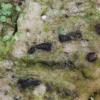
21-12-2025 21:32
Pol DebaenstHello, Garden, Burgweg 19, Veurne, BelgiumOn 10/1

22-12-2025 00:47
Patrice TANCHAUDBonsoir, récolte à proximité du milieu dunaire

21-12-2025 21:40
Isabelle CharissouBonjour, j'aimerais connaitre les références de

21-12-2025 21:31
Pol DebaenstHello, Garden, Burgweg 19, Veurne, BelgiumOn 10/1

21-12-2025 21:31
Pol DebaenstHello, Garden, Burgweg 19, Veurne, BelgiumOn 10/1

20-12-2025 23:08
Patrice TANCHAUDBonsoir, récolte sur sol sablonneux dans l'arri�

21-12-2025 09:32
Hello.A tiny ascomycete found embedded in wood in

20-12-2025 15:47
Mirek GrycHi.These grew on pine wood that was heavily covere
Spores with setulae
Stefan Blaser,
17-07-2020 14:01
Dear all,
I hope someone can help me with this collection:
Substrate: Corticated hardwood twig, possibly Lonicera
Description:
Apothecia 0.2-0.5 mm in diameter, of variable shape but often oblong to slit-like, disc light brownish-translucent with a black cover that tears open to expose the disc.
Asci 31-40(50) x 14-16 µm, saccate, IKI negative. Ascospores 12-15 x 5-6 µm, 1-septate, hyaline, one cell slightly wider than the other, mostly weakly constricted at the septum, both cells with a large oildrop. At both spore ends there are two setulae of about 5-9 µm in length. Paraphyses not observed.
Asci 31-40(50) x 14-16 µm, saccate, IKI negative. Ascospores 12-15 x 5-6 µm, 1-septate, hyaline, one cell slightly wider than the other, mostly weakly constricted at the septum, both cells with a large oildrop. At both spore ends there are two setulae of about 5-9 µm in length. Paraphyses not observed.
Many thanks for any ideas,
Stefan
Hans-Otto Baral,
17-07-2020 16:55

Re : Spores with setulae
Yeah, this is Melaspileella proximella (= Banhegyia uralensis), currently placed in Asterinales.
Stefan Blaser,
17-07-2020 20:30
Re : Spores with setulae
Vielen Dank Zotto!
Ist diese Art nun lichenisiert oder nicht? (In der Schweiz im Flechtenverbreitungsatlas zu finden)
Lieber Gruss,
Stefan
Hans-Otto Baral,
17-07-2020 22:27

Re : Spores with setulae
Ich glaube nicht. Banhegyia galt als nichtlichenisiert, bei Melaspileella könnte lichenicoles Wachstum beobachtet worden sein.




